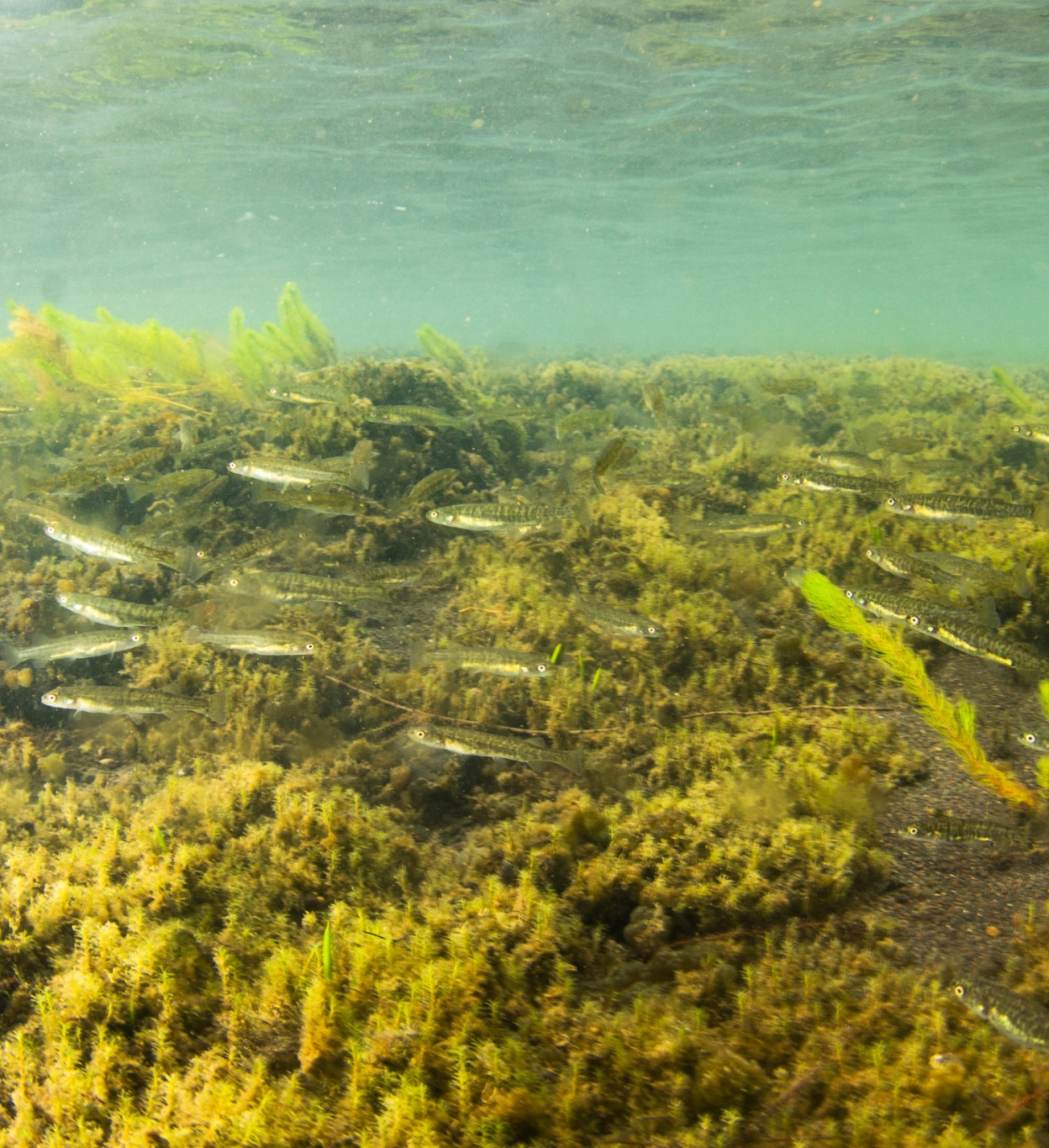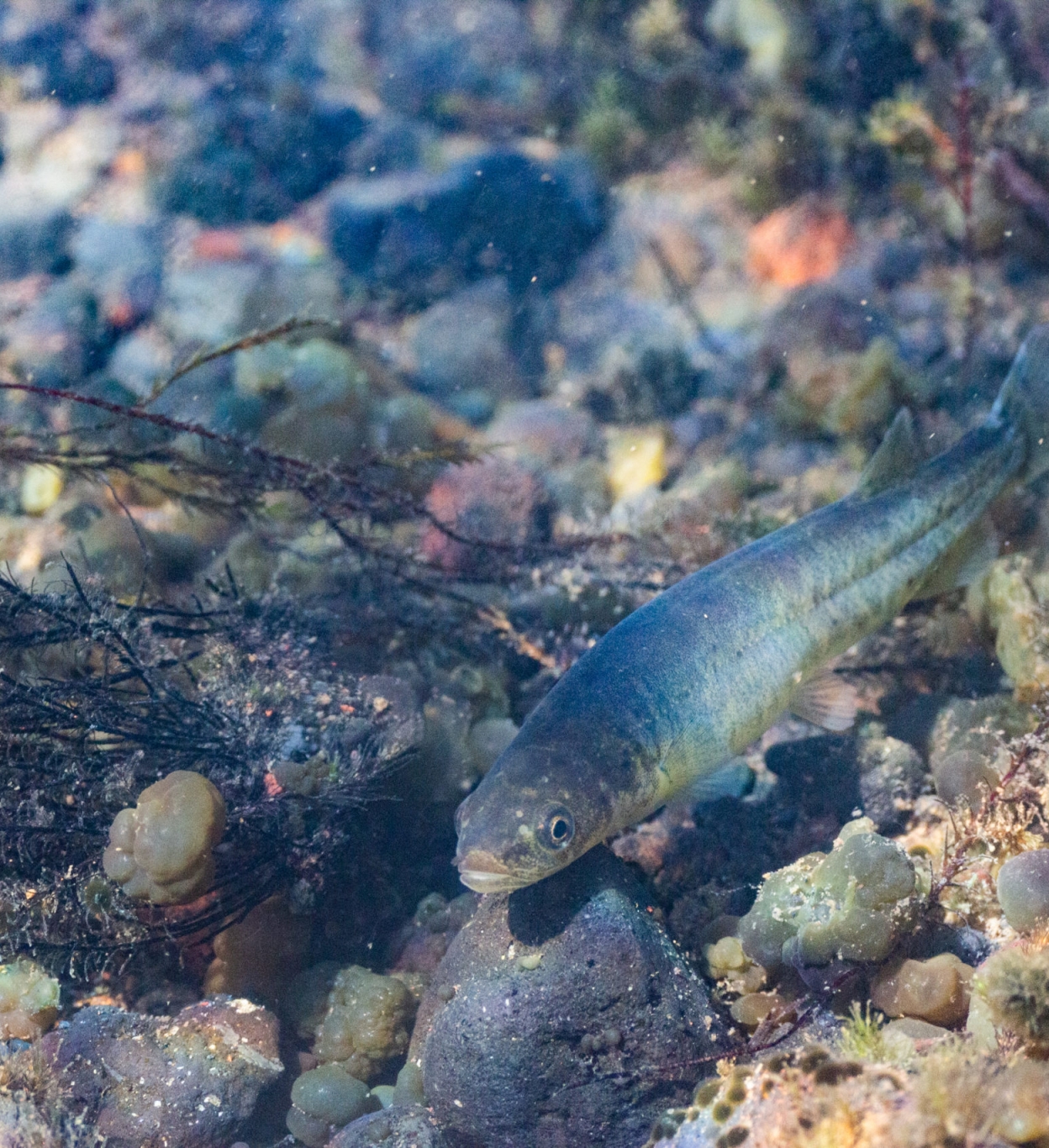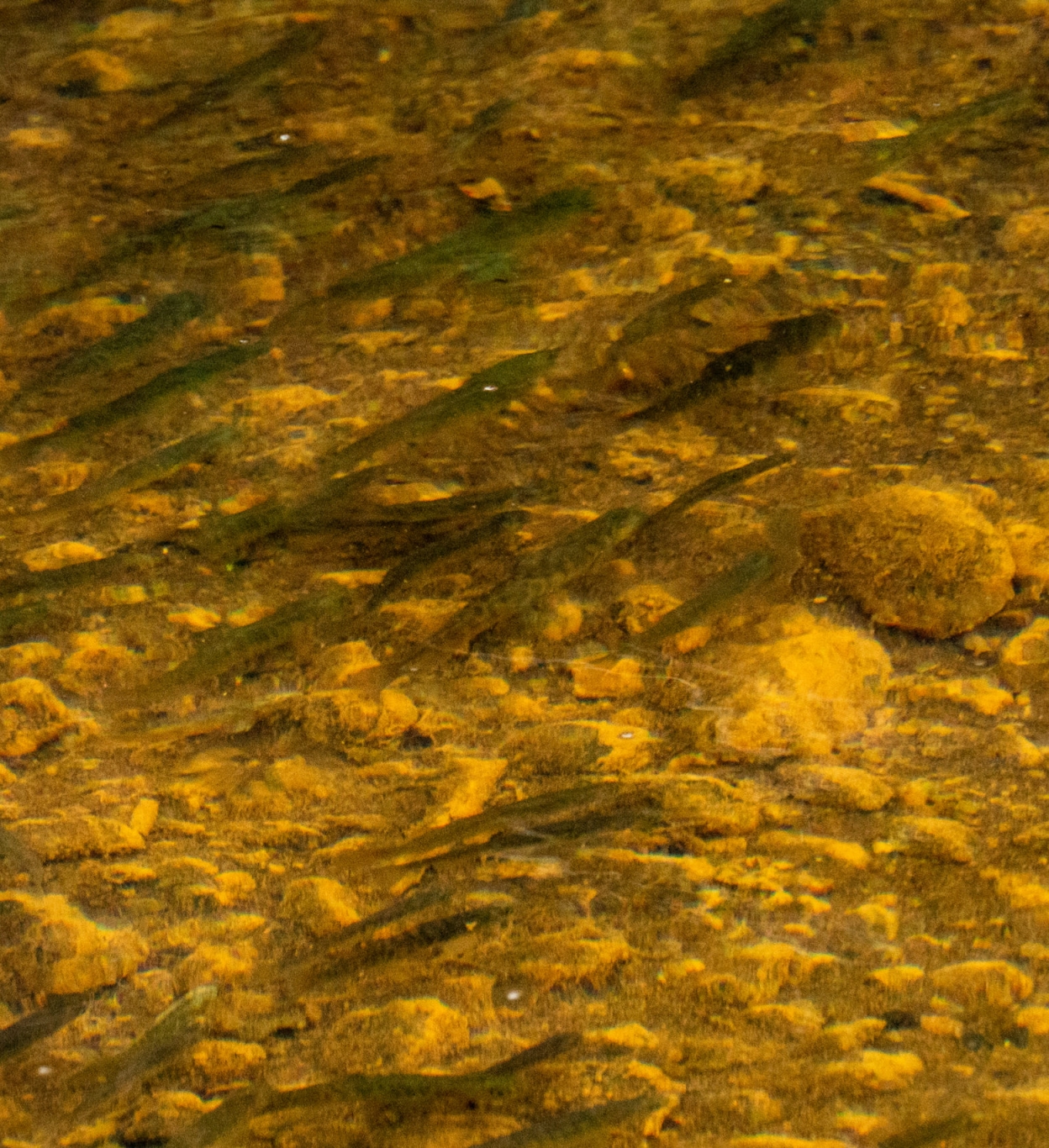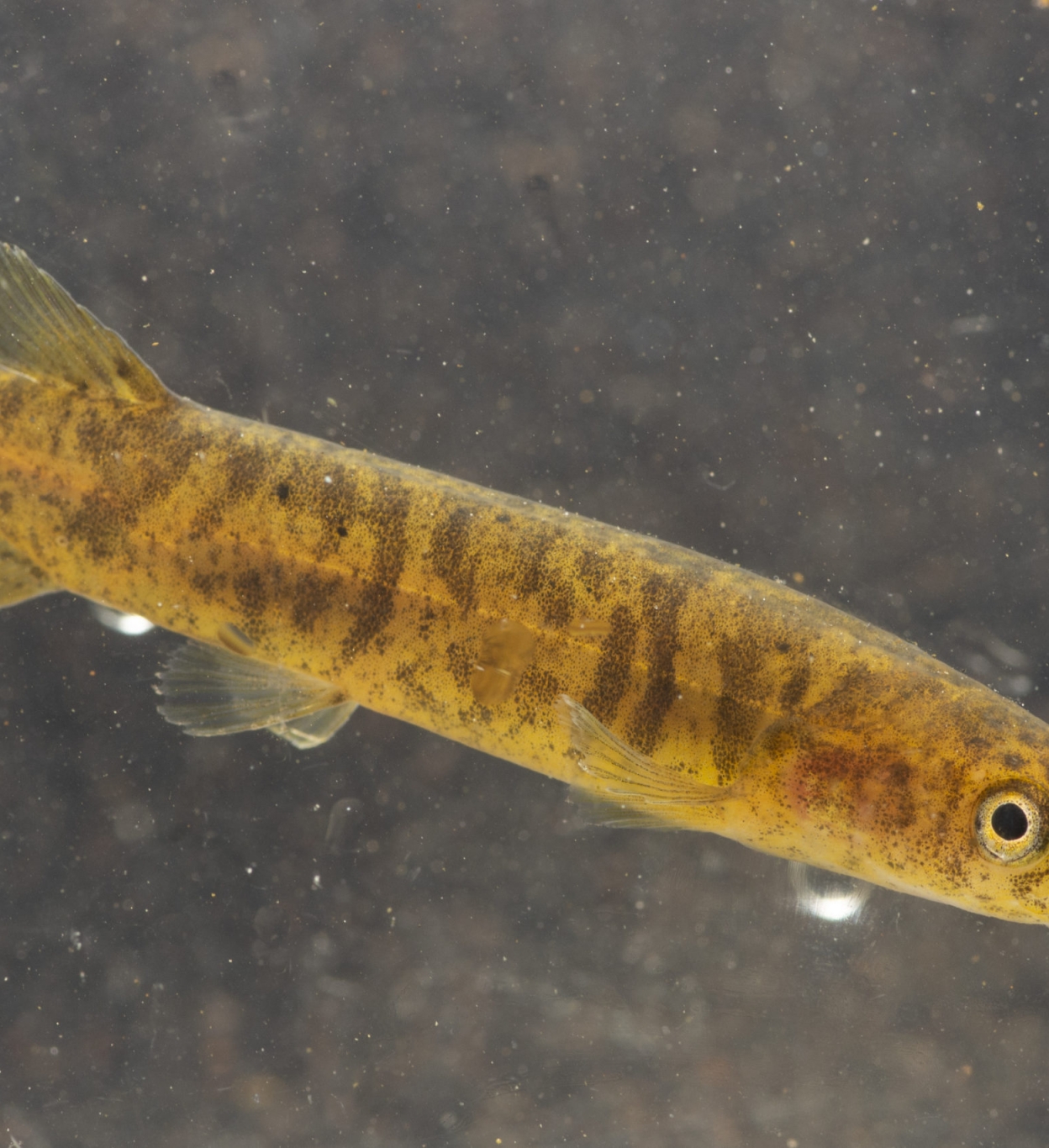Trophic webs of the aquatic ecosystems at the Meullín-Puye Sanctuary
These ecosystems, in this state and with these conditions, are extremely scarce and will become increasingly so due to the accelerated development of the region. It is in this mix of conditions, amongst other factors, that we find an ideal environment to study the biological communities of Patagonia, particularly those that inhabit its inland waters.
One of the conservation targets (CBOs) of the recently declared SNMP is the Puye and other native fish. In the upper part of the Cuervo river basin, where we find the Yulton and Meullín lakes, the only fish species present is the Puye grande Galaxias platei, a species belonging to the galaxiid family (Galaxiidae). This fish is distributed in the rivers and lakes of Chilean Patagonia and Argentina. The adults of this species are adapted to life in the depths of the Patagonian lakes, they have great resistance to low temperatures, are able to see in low light, have a lateral line that allows them to operate in absolute darkness, among other adaptations. Juveniles inhabit the shallow areas of the shores of the lakes, and when they mature they migrate to the deep areas of the lakes.
This species acts as the top predator within these waters. In an effort to better understand the biological communities of the aquatic systems in the SNMP, and thus have better information for their conservation, we are developing a project together with the laboratory of the Universidad Austral, the Aquatic Systems Laboratory (KoLAB). In this project we seek to describe the trophic webs present in these systems. In the first instance, our objective is to model the trophic webs of these different limnetic systems. Once we have the best possible model of these networks, we will aim to describe their structure and functioning. Through these network descriptions we hope to elucidate certain indices about these parameters. Once we have these descriptions these will be useful to position the limnetic ecosystems of the SNMP as reference ecosystems for restoration efforts in ecosystems heavily impacted by human development. In addition, this description will be a baseline of the ecological current state of these food webs, which will allow us in the future to evaluate the effectiveness of conservation efforts or the impact of climate change. Finally, through the study of the topology of the network and using network theory, we will undertake the identification of the key species of this ecosystem.
This fish species acts as the top predator in these waters. In an effort to better understand the ecology of the biological communities of the aquatic systems of the SNMP, where the Puye plays a key role, we are developing a project together with the Aquatic Systems Laboratory (KoLAB) of the Universidad Austral de Chile. This project seeks to describe the trophic webs present in these aquatic systems. Our first objective is to model the trophic webs present in these different limnetic systems. Once we have the best possible model of these networks, we will seek to describe their structure and functioning. With these descriptions we want to elucidate certain indices on key parameters. This information will position the aquatic ecosystems of the SNMP as reference ecosystems for restoration efforts in places heavily impacted by human development. In addition, this description will be a baseline of the current ecological state of food webs, which will allow us in the future the evaluation of the effectiveness of conservation efforts or the impact of climate change. Finally, through the study of the topology of the network and using network theory, we will seek to identify the keystone species of this ecosystem.
Through this research we seek to inform decision-making regarding the conservation of the aquatic environments present in the SNMP. Understanding the structure, functioning and key species of the communities in these ecosystems will allow us to focus our conservation efforts so that the Puye, and all other community components that inhabit these freshwater systems, are preserved efficiently and effectively. In addition, this knowledge will serve as a point of comparison for restoration projects that seek to restore ecosystems to their natural state in places that have been severely damaged by human activity. Diffusion of the functioning, and therefore the importance, of these often invisible species and communities is a fundamental pillar of the project, which is why the results obtained will be communicated through multiple channels.
This project seeks to describe the trophic webs present in these aquatic systems, where the Puye grande is the top predator.
These ecosystems, in this state and with these conditions, are extremely scarce and will become increasingly so due to the accelerated development of the region. It is in this mix of conditions, amongst other factors, that we find an ideal environment to study the biological communities of Patagonia, particularly those that inhabit its inland waters.
One of the conservation targets (CBOs) of the recently declared SNMP is the Puye and other native fish. In the upper part of the Cuervo river basin, where we find the Yulton and Meullín lakes, the only fish species present is the Puye grande Galaxias platei, a species belonging to the galaxiid family (Galaxiidae). This fish is distributed in the rivers and lakes of Chilean Patagonia and Argentina. The adults of this species are adapted to life in the depths of the Patagonian lakes, they have great resistance to low temperatures, are able to see in low light, have a lateral line that allows them to operate in absolute darkness, among other adaptations. Juveniles inhabit the shallow areas of the shores of the lakes, and when they mature they migrate to the deep areas of the lakes.
This species acts as the top predator within these waters. In an effort to better understand the biological communities of the aquatic systems in the SNMP, and thus have better information for their conservation, we are developing a project together with the laboratory of the Universidad Austral, the Aquatic Systems Laboratory (KoLAB). In this project we seek to describe the trophic webs present in these systems. In the first instance, our objective is to model the trophic webs of these different limnetic systems. Once we have the best possible model of these networks, we will aim to describe their structure and functioning. Through these network descriptions we hope to elucidate certain indices about these parameters. Once we have these descriptions these will be useful to position the limnetic ecosystems of the SNMP as reference ecosystems for restoration efforts in ecosystems heavily impacted by human development. In addition, this description will be a baseline of the ecological current state of these food webs, which will allow us in the future to evaluate the effectiveness of conservation efforts or the impact of climate change. Finally, through the study of the topology of the network and using network theory, we will undertake the identification of the key species of this ecosystem.
This fish species acts as the top predator in these waters. In an effort to better understand the ecology of the biological communities of the aquatic systems of the SNMP, where the Puye plays a key role, we are developing a project together with the Aquatic Systems Laboratory (KoLAB) of the Universidad Austral de Chile. This project seeks to describe the trophic webs present in these aquatic systems. Our first objective is to model the trophic webs present in these different limnetic systems. Once we have the best possible model of these networks, we will seek to describe their structure and functioning. With these descriptions we want to elucidate certain indices on key parameters. This information will position the aquatic ecosystems of the SNMP as reference ecosystems for restoration efforts in places heavily impacted by human development. In addition, this description will be a baseline of the current ecological state of food webs, which will allow us in the future the evaluation of the effectiveness of conservation efforts or the impact of climate change. Finally, through the study of the topology of the network and using network theory, we will seek to identify the keystone species of this ecosystem.
Through this research we seek to inform decision-making regarding the conservation of the aquatic environments present in the SNMP. Understanding the structure, functioning and key species of the communities in these ecosystems will allow us to focus our conservation efforts so that the Puye, and all other community components that inhabit these freshwater systems, are preserved efficiently and effectively. In addition, this knowledge will serve as a point of comparison for restoration projects that seek to restore ecosystems to their natural state in places that have been severely damaged by human activity. Diffusion of the functioning, and therefore the importance, of these often invisible species and communities is a fundamental pillar of the project, which is why the results obtained will be communicated through multiple channels.




